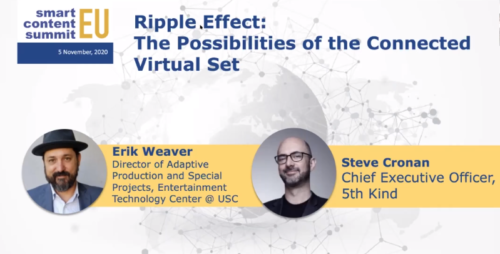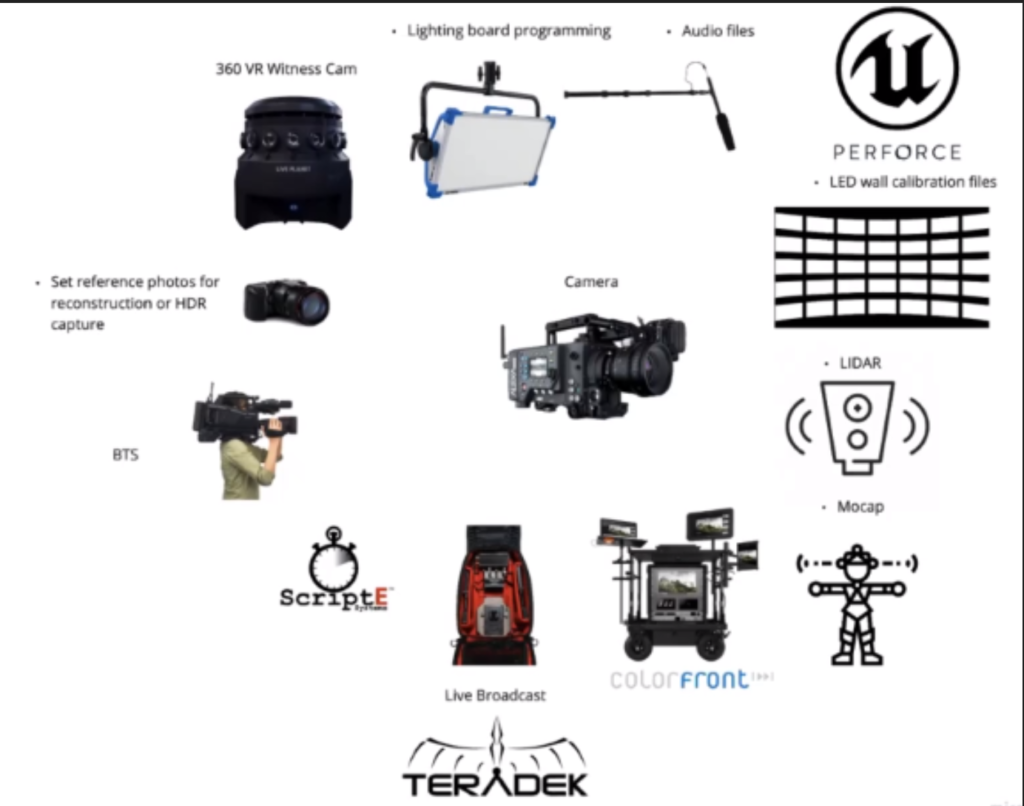Exclusives

5th Kind CEO: C4, Metadata and New Tools are Making Virtual Production Possible
Story Highlights
Production companies can use SMPTE’s C4 ID standard and interoperable metadata to integrate a wide range of tools today to drastically enhance and drive efficiencies in the production pipeline now that virtual productions are possible, according to Steve Cronan, 5th Kind CEO, and Erik Weaver, director of Adaptive Production and Special Projects at the Entertainment Technology Center at the University of Southern California (ETC @ USC).
The revolutionary proof-of-concept project called “The Ripple Effect” brought together creatives and technology companies to develop new ways of leveraging cloud-based and emerging platform approaches to making content.
“What ‘Ripple Effect’ is is the exploration not only of COVID safety best practices and applying metadata to that, but also looking at virtual production” and adding that to the equation, Weaver said Nov. 5 during the online Smart Content Summit EU event.
“Ripple Effect” is an R&D short film project that tested virtual and remote production using “large LED volumes, very much like you see on” the Disney Plus Star Wars TV show The Mandalorian, “where the background is pretty much all a whole set developed in a game engine so that you get parallax and it looks very real,” Weaver pointed out during the Smarter(er) Localisation breakout session“Ripple Effect: The Possibilities of the Connected Virtual Set.”
 “That’s really going to be the future,” he predicted, adding: “You’re going to see a lot more [productions] doing this.”
“That’s really going to be the future,” he predicted, adding: “You’re going to see a lot more [productions] doing this.”
Weaver and his colleagues at the USC program have “really cared about metadata over the years, and so on this project we had an opportunity to really develop a brand new pipeline and try and understand how to connect these things,” he said.
In the past, ETC had rolled out C4 that he noted serves as a unique identifier of digital assets. With “Ripple Effect,” “we were looking at what are the new key tools going to be required to build the pipeline for virtual production,” he said. C4 “eased the development, or the API integrations, in between the different tool sets” it used, he pointed out.
The C4 “hash” used for the project allows you to have a unique identifier for a file,” Cronan noted, explaining: “What’s great about having an agreed-upon hashing mechanism for a file is that even in a distributed world where the files can be captured on set or sitting at home in your office, that hash can be run at any time to create this unique identifier that allows us to create these relationships. So it’s really allowing us to kind of maintain these relationships a little more automated because we use the properties of the file itself as this unique identifier.”
And “that’s super valuable because now all of a sudden you can have a set of rules that describe how you get the same identifier and you don’t have to use a centralised database or any mechanism like that, which is much more traditional,” according to Weaver. “So why this is a big difference is because now you don’t really have to have a sidecar file, you don’t have to have an embedded file,” he said, explaining: “Instead, all you have to have is your own database where you’re tracking some of these IDs and that you’re indexing in the different places and you’re correlating that metadata. And that metadata correlation brings out a world of benefits.”
Explaining one of those benefits, Cronan said: “We can quickly and easily drop in the C4 application and analyse any file to extract what is essentially like a global unique ID that, even if the files are distributed, everyone’s going to end up with the same global unique ID. So that distributed, yet unified, approach to creating an identifier has been extremely valuable to sort of connecting all the different pieces of this pipeline.”
Also, there are “these silos of metadata that we discovered when we first started looking at things,” Weaver noted, adding: “You couldn’t consistently say on any particular project ‘I know exactly how this…workflow is going to work’.” However, it “just simplifies everything,” he said.
 Meanwhile, an “exciting new development” and an “evolution of what’s happening now with the connected set” is that productions can “not only minimise potentially the amount of people on set to reduce risk, but also adjust for… what happens if someone tests positive during the process,” according to Cronan. “We’re thinking … how could you potentially do any role remotely?” he said, noting that includes script supervisor, continuity and “potentially even directing fully remotely.”
Meanwhile, an “exciting new development” and an “evolution of what’s happening now with the connected set” is that productions can “not only minimise potentially the amount of people on set to reduce risk, but also adjust for… what happens if someone tests positive during the process,” according to Cronan. “We’re thinking … how could you potentially do any role remotely?” he said, noting that includes script supervisor, continuity and “potentially even directing fully remotely.”
To that end, “we were able to integrate Teradek” video solutions “into not only the live camera feed, but also” use them to create “a platform that allows you to have remote viewing of your production and collaboration,” Cronan said, adding: “That ecosystem of having a sort of on-set portal, I think, is now an inevitable evolution of what’s coming together.”
And, “as we get into this whole new world of virtual production, there’s going to be a bunch of new tools also popping up – things like Perforce” software, Weaver said.
“What you’re going to find when you deal with LED volumes and virtual pre-production is your pipeline does change quite a bit,” Weaver went on to say. “You have to shift a lot more into pre-planning,” he noted, explaining: “It’s much more like traditional film where you have to be ready” before you start shooting and “then you can get your shots in-cam. I would say that you’re shifting probably 70-plus percent upfront. You still probably might have a thing or two in cleanup and VFX but I would say it’s radically decreased.”
During the Q&A, Cronan said he sees the need for some sort of a streaming supervisor on virtual productions — “someone who’s responsible for ensuring that remote component of now getting the streams, the data from set to” off the set. What’s not quite clear just yet is who that job will fall to – and whether it will be a hybrid or dedicated role to handle the remote component, he said, noting that had yet to be determined.
Click here to access the full presentation.
Smart Content Summit EU was produced by MESA and MESA Europe, in association with CDSA, HITS and the Smart Content Council, which meets regularly to share best practices, evaluate emerging technologies and collaborate to accelerate the pace of transformation in our industry. The summit is sponsored by ATMECS, Cognizant, Deluxe, Digital Nirvana, Éclair, Eluvio, EIDR, Iyuno Media Group, TransPerfect, NAGRA, Premiere Digital, Zixi, Whip Media Group, AppTek and EIDR.









